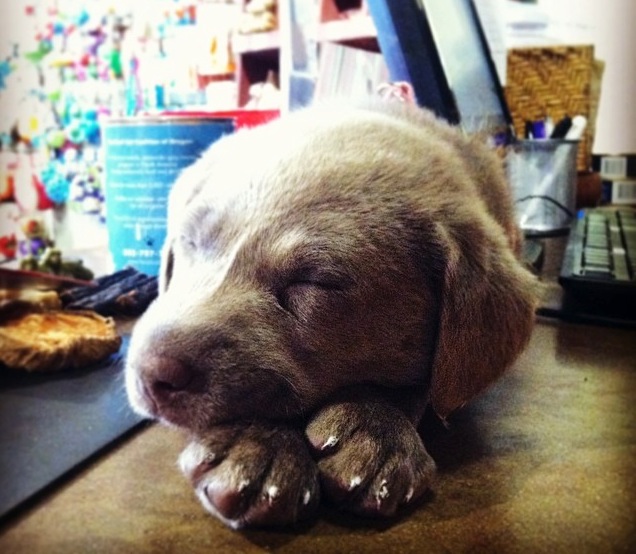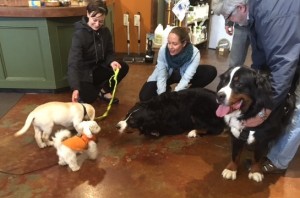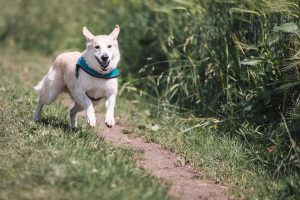 The “Come!” command is one of the very most important things we can teach our dog. A reliable recall is imperative to get them quickly to safety, to recover them if they happen to get out the door, and to proactively remove them from a situation at the dog park that might evolve into trouble. It’s also a wonderful luxury when you are in a safe quiet place to be able to have your dog off leash and know you can get him right back when you want to.
The “Come!” command is one of the very most important things we can teach our dog. A reliable recall is imperative to get them quickly to safety, to recover them if they happen to get out the door, and to proactively remove them from a situation at the dog park that might evolve into trouble. It’s also a wonderful luxury when you are in a safe quiet place to be able to have your dog off leash and know you can get him right back when you want to.
Green Tip – please be very conscious of the negative environmental impact of off-leash dogs in some habitats (forests, dunes, etc) Read more here
Like the command “Drop It!”, it’s easy to accidentally make mistakes when training this behavior that can undermine your success. Let’s look at what might commonly happen:
*Let’s say your dog doesn’t really like bath time. He’s chewing on a bone and you say “Come!” and you remove him from his chew and bring him straight to the bathtub.
*Your dog is playing at the park with his buddies, and you decide it’s time to go. You say “Come!” and drive him away from the park – playtime is over.
*Your dog gets out the door. You’re very frightened when you see it happen as your dog darts right out to the busy street. Nightmare pictures flash in your mind of your baby hit by a car. You’re shouting at your dog to come, but he doesn’t listen. By the time you catch him you’re beside yourself and you’re very angry with 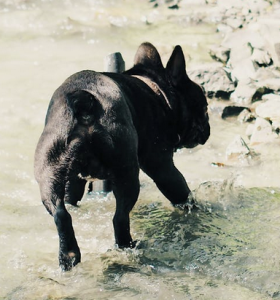 him, and you tell him he’s bad and drag him back to the house and put him in time out.
him, and you tell him he’s bad and drag him back to the house and put him in time out.
See a pattern? From your dog’s perspective, that word “come” is becoming a pretty bad word. When he hears it, his heart might sink. He thinks, “Bad things might be starting, “My fun might be ending”, or “I’m about to be punished”. You don’t want him to hear that word and weigh his options, or worse, you don’t want to say that word and have him take off on you in the other direction! Don’t “poison” your cue. Protect this word!
Here’s your best road to success:
You want that word come to be the very most awesome thing your dog hears from you. “Come!” means opportunity, you’d better hurry over! “Come!” means dinnertime! “Come!” means you might have a fun new toy for him! “Come!”means good things are starting! “Come!” means his favorite friends are here to see him! “Come!” means delicious things are possible! You want his heart to LIFT when he hears that word. You want him to hurry over to see what it is so he doesn’t miss out!
Here’s How To Start:
First, keep your recall command consistent (I’ll be referring to it as “Come!” but it can be whatever you like), and of course ONLY use it for good things (for now). And remember: always end training sessions on a high note!
Start by inviting him to come to you from a foot away inside the house when he’s not occupied with anything exciting. Say “Come!” and then pat your legs, get lower to the ground, make kissy noises, or whatever will prompt him to come closer and when he does, say “yes!” And give him a great treat. Back up a few feet and do it again. Show him a treat, say “come” and run a few feet away from him, getting him to run along with you a little. When he does, say “yes!” and give him a treat and a party. What fun! If it’s dinner time, use the word “come!”. If you have a new toy you bought, don’t waste the opportunity – maybe tuck it into the back of your pants, call him to “come” and when he gets there, say “yes!” And give him a party, whipping out the new toy as a surprise bonus! Wow! Cool! What a fun word!
On leashed walks when everything is calm and boring, suddenly get animated and bouncy and say “Benny, come!” And get him to run for a few yards with you while you’re unexpectedly fun. Reward him with pets and a treat, then let everything get boring again. When he’s forgotten about that, do it again. Having a little fun starting up during a quiet time and running along with you are both reinforcing for this behavior.
If you have a helper or three, recall games are fun for everyone! Start somewhere like a hallway indoors or a big room. First have one person hold your dog by his leash. You get a good treat and let him sniff it. Then while your helper continues to hold him, you run 10 or 15 feet away, then turn back around and enthusiastically say, “Benny, Come!” The person holding him releases him right away when you say that command and you continue to cheerlead him the whole way to you. When he gets to you, reach towards him under his chin, gently take his collar with one hand and and give him the treat with the other hand (with big praise).
-The reason that person holds him until you stop running and turn around to call him is to build up anticipation – they love to chase!
– The reason you take his collar when he gets to you is that by making it a regular part of the recall, you’re sure to have him securely when he is frightened or startled in the real world and might dash away. He’ll also be so used to it that he won’t be startled if someday a stranger takes him by the collar.
-The reason you have him drag his leash and you vocally cheerlead/encourage him as he comes to you is that the world is a distracting place. When you move this game to new places, you’ll want the whole thing to be fun and keep him engaged in the game. If he stops and sniffs stuff or spots a squirrel, you can say “Oops!” and get his leash and encourage him to finish running along with you the rest of the way on the leash and reward that.
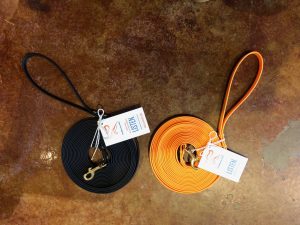 Step Two: As he gets better at this game and is pretty reliably racing towards you indoors, bring him out to the yard.
A long line is an incredibly handy thing to have for outdoor exercises – these are light leashes that are 20 or more feet long. If you don’t have one, have him drag his leash. You’ll especially want a long line later when you start to work in more distracting areas like a park. “Come” should always be positive and fun, but it shouldn’t be optional. This does not mean anything about punishment but it does mean something about follow-through. You don’t want to inadvertently reinforce a chase game if your dog decides to ditch your game and run off! Getting him to finish the task and get the reward is an important step. If he does get distracted, work in an easier area with fewer risks of distraction and for shorter periods of time. End with a successful run to you before it becomes any sort of chore. You want this to be a fun game that he wishes wouldn’t stop!
Step Two: As he gets better at this game and is pretty reliably racing towards you indoors, bring him out to the yard.
A long line is an incredibly handy thing to have for outdoor exercises – these are light leashes that are 20 or more feet long. If you don’t have one, have him drag his leash. You’ll especially want a long line later when you start to work in more distracting areas like a park. “Come” should always be positive and fun, but it shouldn’t be optional. This does not mean anything about punishment but it does mean something about follow-through. You don’t want to inadvertently reinforce a chase game if your dog decides to ditch your game and run off! Getting him to finish the task and get the reward is an important step. If he does get distracted, work in an easier area with fewer risks of distraction and for shorter periods of time. End with a successful run to you before it becomes any sort of chore. You want this to be a fun game that he wishes wouldn’t stop!
Note: (IF for some reason he is collar-shy, work on that issue separately for now. Slowly desensitize it in a quiet setting by reaching towards him, perhaps towards his chest at first but not touching him and rewarding this until it’s not scary, then scratching him under his chest for a reward with the other hand, working slowly with good treats closer to gentle touches to the collar, etc. Watch for stiffening of his body or a glimpse of “Whale Eyes” and go back to what was easier.
Third Step: Practice the same indoor chase-me exercises outdoors, with better treats.
Then if you have a third person (or more), space out in a rough circle, not too far away from each other, and take turns calling the dog to come, so he’s bouncing from one person in the circle to another. Remember each time to use his name, call him to come and cheerlead him as he comes, and take his collar and give a treat. Then the next person does the same.
Sometimes when he does a really good recall, take a break and play a game as a reward. Fetch is good if he’s into that, or a have a game of tug. Fun things happen when you come!
Forth Step: if you have three people, have a person be a (minor) distractor. Use better treats, and perhaps have your dog drag his leash or be on a long line. If you and one other helper are calling him back and forth, have the third person stand to the side of the recall path while he runs by, or casually walking across the path. Reward well for ignoring that distractor. Then maybe that distractor does something slightly playful: hop from foot to foot nearby, or stand holding a ball, bouncing it lightly in your hand. The person calling should be animated. If the dog is distracted, the caller should scoop up his leash and encourage him to run along with them to the end point, and get a little reward. Don’t increase the challenge until he does well ignoring that level of distraction. If the dog does well, the next step will be to make the distractions harder. Tossing a favorite toy into the air, or running across the path, etc. If he veers, the caller could use a marker word if you already have one “Oops!, or “nope!” Or “Uh-uh” and see if you can cheerlead him to bring him back on course. If you’re able to convince him with your enthusiasm to change course back to coming to you without having to use the leash, make a big deal out of it. Give him a jackpot! Jackpot means you give a series of treats, one at a time with a slight pause between treats. This feels like a lot of treats to a dog (as opposed to a handful of treats, which = ONE handful.) What you’re showing him is that he gets the best/most rewards when he makes the decision to ignore a distraction.
Another good addition is making “Sit!” be part of the recall. As he approaches, stand tall and ask for sit, perhaps with a slightly exaggerated hand signal if you’ve got one, then take his collar and reward well.
Almost There! Once he’s a rockstar in your yard, bring him to a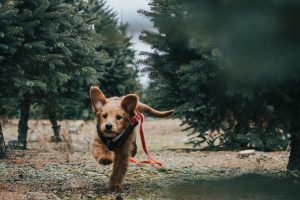 more public park and use your long line. Start closer together at first in a quieter area, and work up to a more distracting area. Remember to end on a good note!
more public park and use your long line. Start closer together at first in a quieter area, and work up to a more distracting area. Remember to end on a good note!
Work on Calling Him Away From Fun: Once you’re doing well with the park, a very good exercise if you happen to frequent an enclosed dog park is to go with a few treats in your pocket. When your dog has already been playing and then it’s one of those quiet moments maybe just sniffing the ground, call his name from a short distance away and if he even looks towards you, say “Yes!” and give him a treat and then tell him to “Go Play!” again. Then wait a bit and call him to “Come!” during another quiet-ish moment, and cheerlead him as he comes. Reward this very well, maybe even with a jackpot moment, and then tell him to “Go Play!” again. This is a great way to show him that “Come” doesn’t necessarily mean fun is over, and also works on coming with distractions around. Maybe when you leave you can use the “Want to Go For A Ride?” or “Want to Go To Green Dog?” to continue the fun instead of just ending it.
Important Tip:
If in real life he decides not to come in the face of something too exciting, try not to punish him when you do get him back. Remember that a reward or a punishment is always associated with what happened right before, meaning punishing him when he lets you finally catch him will be punishing him for getting caught/coming to you. These are things you don’t want to discourage.
Instead: Try to see if he’ll come to you as you run away a bit, like your exercises. Reward it very well if he comes! A strange but effective tactic that works on many dogs in an emergency is if you drop to the ground, perhaps making a high pitched noise. If you’ve ever watched Funniest Home Videos, you could make a drinking game out of the number of people falling and then a dog racing right to them from off screen! Even getting on your hands and knees and pretending to look intensely at something in the grass can be irresistible to some dogs. Try it in your yard!
If your dog is off leash and doesn’t come to you, go back to using a long line for a while. Don’t let them have too much practice ignoring this cue – just go back a step or two and work near distractions on a long line to better solidify the behavior.
You might ask:
“But what about all those other times I listed in the beginning of this article where I want to call him away from something he’s enjoying or towards something that’s not so fun?” The good news is that the English language has loads of great words, like “Bath time!” “Let’s Go!” “Want to go for a ride?”, etc. Make sure you reward these words well too, especially early in life, and work on making those experiences more positive.
 For example, if bath time is scary, can you come up with ways to make it less so? You could put a rubber mat in the tub to make it less slippery, you could smear peanut butter along the inside edge of the tub (or we have rubber textured licking surfaces that adhere to the tile or tub that they can lick stuff off of to distract them from the activity), you could have a second person holding a frozen treat to lick, or you could try to do it outdoors on a hot day. Bath time (or other un-favorite activity) could also always end in a super awesome favorite treat/chew that is reserved for bath or grooming sessions, (or is hidden in the car for when he came away from the dog park fun) making it at least a begrudging acceptance of the task in anticipation of that great thing.
For example, if bath time is scary, can you come up with ways to make it less so? You could put a rubber mat in the tub to make it less slippery, you could smear peanut butter along the inside edge of the tub (or we have rubber textured licking surfaces that adhere to the tile or tub that they can lick stuff off of to distract them from the activity), you could have a second person holding a frozen treat to lick, or you could try to do it outdoors on a hot day. Bath time (or other un-favorite activity) could also always end in a super awesome favorite treat/chew that is reserved for bath or grooming sessions, (or is hidden in the car for when he came away from the dog park fun) making it at least a begrudging acceptance of the task in anticipation of that great thing.
Happy Recall, Y’all!

By Christine Mallar, Co-owner, Green Dog Pet Supply. Christine has 30 years of positive reinforcement training experience with dogs, cats and captive exotic animals.
Other articles in this puppy series:
Tips for New Puppy Owners
Congratulations on your new puppy! What a fun time you’ll have! We very much want your new baby to live a long, healthy, happy life, so we thought we’d compile some of the nitty-gritty dos-and-don’ts of puppy care. Socialization, nutrition, our favorite chews, tips on potty training, etc!
Raising a Puppy (Or Any New Dog) During Covid19
All of us feel frightened and unsure of how long we’ll be living in this strange, suspended, frightening reality. A new dog is not just a delightful distraction from boredom- that little soul can really be a life raft for your psyche. But, this new-puppy-during-quarantine situation does come with a few unique challenges. How to work on socialization and help to prevent separation anxiety once you go back to work.
What Do They Want? How Should They Get It? (Foundational Thinking For Creating Good Behavior in puppies and kittens! Part One) Often we hapless humans try our best to tell our puppies (and kittens) what we want them to do or especially not do, yet the bad behaviors increase and we struggle to get them to be what we wish they would be, especially when it comes to attention-getting behaviors. I’m here to offer a few rules of thumb for most any behavior you don’t like.
To Treat Or Not To Treat? (Foundational Thinking For Creating Good Behavior In Dogs Part 2 : Choose Your Methods of Training Carefully, especially with Reactive/Fearful Dogs.
This is the second article in the series that I call “foundational thinking”, as once you understand how dogs think and learn, and the concepts behind why you use certain methods, you can train just about any behavior you like! I think this article contains what I believe to be some of the most important information I can give you about why we use positive reinforcement, and the dangers of using dominance theory and aversive methods especially when dealing with situations that are uncomfortable for dogs.
Do I Always Have To Use Treats? (Foundational Thinking For Creating Good Behavior In Dogs Part Three) A lot of people worry about training with treats.
* Do I have to keep giving them treats for everything for the rest of their lives?
* Aren’t I bribing them?
* I want them to do things because they want to please me.
* I want them to do things right away and I don’t want to have to show them a treat to get them to listen.
These are all good questions. Here’s how to help your dog be able to do what you ask of them the first time you ask, while continuing to build a good relationship.
Drop It!
We’re continuing our puppy series with discussions of common training challenges. It’s so easy to accidentally create a dog that runs away from you when they get a hold of something they shouldn’t have. Wouldn’t you rather they spit something out of their mouth when you approach? You can do it!


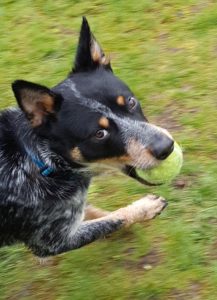 A recent customer brought home his 8 week old puppy, and was shocked the second day when he went to take something from her and his tiny little angel growled at him. He came straight into the store very worried that he had adopted a Cujo puppy with a vicious streak. I want to reassure you: protecting resources is a very natural behavior for dogs, and actually for all animals including people. Lions aren’t keen on hyenas stealing their hard-won meal. Think about how much you have to actively teach and remind your toddlers to share – it doesn’t exactly come naturally. Even though our mommas might have taught us well, think about how you might react if a stranger walked by your table in a restaurant and took a handful of your french fries! However, don’t despair, there’s absolutely no reason you can’t teach your new puppy to happily surrender what’s in their possession to their humans!
A recent customer brought home his 8 week old puppy, and was shocked the second day when he went to take something from her and his tiny little angel growled at him. He came straight into the store very worried that he had adopted a Cujo puppy with a vicious streak. I want to reassure you: protecting resources is a very natural behavior for dogs, and actually for all animals including people. Lions aren’t keen on hyenas stealing their hard-won meal. Think about how much you have to actively teach and remind your toddlers to share – it doesn’t exactly come naturally. Even though our mommas might have taught us well, think about how you might react if a stranger walked by your table in a restaurant and took a handful of your french fries! However, don’t despair, there’s absolutely no reason you can’t teach your new puppy to happily surrender what’s in their possession to their humans!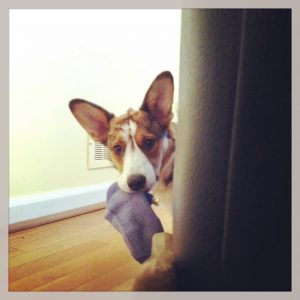 mouth that she encounters) chews on something like your shoe. You gasp and run over, yank the shoe away and leave her with nothing. Then she’s chewing on an absolutely delicious bully stick but you notice it’s getting floppy and short enough to swallow, so you approach her hastily and take it away. Hmmm. Not so fun. Maybe next time she finds a sock and as you rush over to take it away from her, she runs away with it. She’s starting to understand that if she has something and you rush over saying “no”, you’re going to take it away for sure, and maybe she doesn’t want to lose that fun thing. As she runs away with it, you chase her around (perhaps pretty fun, actually) and when you get the sock in your hand she tugs against it (really fun!) And then she loses it. (Boo. Game over. No fun at all.)
You are in fact actively teaching her not to let you get something she wants to keep, or perhaps that if she’s bored, grabbing something that elicits a chase and tug game is a pretty great idea. If you’re ripping away her most delicious chew, she’s very much NOT going to be motivated to give that up next time, and may even start to get defensive about you “stealing” it away from her. She’s no dummy. She can see patterns in your behavior and learn from them, but unfortunately you might be inadvertently teaching her behaviors that might infuriate you.
mouth that she encounters) chews on something like your shoe. You gasp and run over, yank the shoe away and leave her with nothing. Then she’s chewing on an absolutely delicious bully stick but you notice it’s getting floppy and short enough to swallow, so you approach her hastily and take it away. Hmmm. Not so fun. Maybe next time she finds a sock and as you rush over to take it away from her, she runs away with it. She’s starting to understand that if she has something and you rush over saying “no”, you’re going to take it away for sure, and maybe she doesn’t want to lose that fun thing. As she runs away with it, you chase her around (perhaps pretty fun, actually) and when you get the sock in your hand she tugs against it (really fun!) And then she loses it. (Boo. Game over. No fun at all.)
You are in fact actively teaching her not to let you get something she wants to keep, or perhaps that if she’s bored, grabbing something that elicits a chase and tug game is a pretty great idea. If you’re ripping away her most delicious chew, she’s very much NOT going to be motivated to give that up next time, and may even start to get defensive about you “stealing” it away from her. She’s no dummy. She can see patterns in your behavior and learn from them, but unfortunately you might be inadvertently teaching her behaviors that might infuriate you.
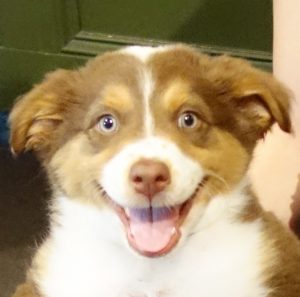


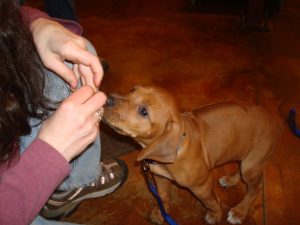 the dog is standing and you put a treat right up to her nose (even touching her right under her nose with it, and move it up and back slowly so she’s following it. This makes her head point up towards the ceiling, and she might start to sit “by accident” because she’s following that treat. When her butt touches the floor, say “yes!” right at that moment and give her the treat and praise her. Do it a few more times the same way. Now it might be getting faster, as she’s starting to realize that when she gets into that position, she gets a treat. Now you can start saying the word “sit” right when you bring the treat to her nose. After a few repetitions, she’s going to start to build an association with the sound of the word sit, that it predicts that you’re going to be doing the thing where her butt touches the ground. End the session on a high note.
the dog is standing and you put a treat right up to her nose (even touching her right under her nose with it, and move it up and back slowly so she’s following it. This makes her head point up towards the ceiling, and she might start to sit “by accident” because she’s following that treat. When her butt touches the floor, say “yes!” right at that moment and give her the treat and praise her. Do it a few more times the same way. Now it might be getting faster, as she’s starting to realize that when she gets into that position, she gets a treat. Now you can start saying the word “sit” right when you bring the treat to her nose. After a few repetitions, she’s going to start to build an association with the sound of the word sit, that it predicts that you’re going to be doing the thing where her butt touches the ground. End the session on a high note.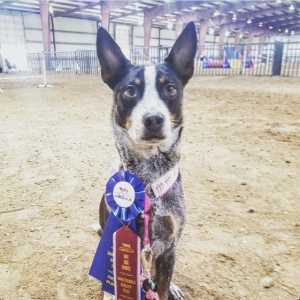
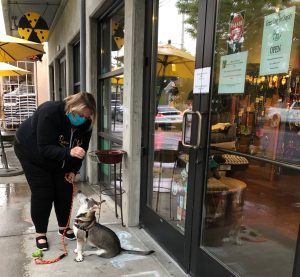
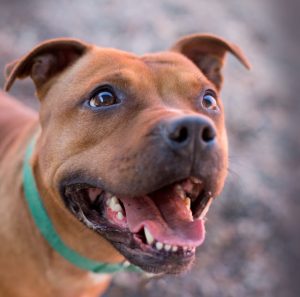
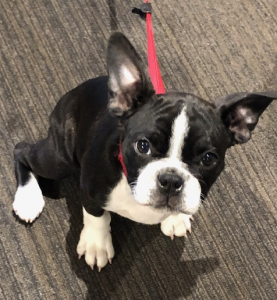 We’ve seen a surprising number of customers with brand new puppies in the store these past few weeks! There are also reports of shelters getting cleaned out of both cats and dogs around the country – yay! But Why? I was a little surprised at first, but I quickly realized there were two good reasons. What I heard from customers was that they thought that with all of the time they had on their hands, they could really concentrate on training a puppy. Later I also started to realize that this is a very scary time. All of us feel frightened and unsure of how long we’ll be living in this strange, suspended, frightening reality. A new dog or cat is not just a delightful distraction from boredom- that little soul can really be a life raft for your psyche. When a puppy comes into the store right now, we’re incredibly grateful for the visit – it helps us have a moment of sweetness and laughter in our crazy upended lives of scurrying around putting together orders for curbside pickup, interacting with most people by phone and trying to get the people who are visiting in and out quickly (we do allow two people in the store at a time right now). We stop for a moment and soak in the puppiness. I can see both the logic and the emotional benefits of this decision for sure. But, this new-puppy-during-quarantine situation does come with a few unique challenges.
We’ve seen a surprising number of customers with brand new puppies in the store these past few weeks! There are also reports of shelters getting cleaned out of both cats and dogs around the country – yay! But Why? I was a little surprised at first, but I quickly realized there were two good reasons. What I heard from customers was that they thought that with all of the time they had on their hands, they could really concentrate on training a puppy. Later I also started to realize that this is a very scary time. All of us feel frightened and unsure of how long we’ll be living in this strange, suspended, frightening reality. A new dog or cat is not just a delightful distraction from boredom- that little soul can really be a life raft for your psyche. When a puppy comes into the store right now, we’re incredibly grateful for the visit – it helps us have a moment of sweetness and laughter in our crazy upended lives of scurrying around putting together orders for curbside pickup, interacting with most people by phone and trying to get the people who are visiting in and out quickly (we do allow two people in the store at a time right now). We stop for a moment and soak in the puppiness. I can see both the logic and the emotional benefits of this decision for sure. But, this new-puppy-during-quarantine situation does come with a few unique challenges.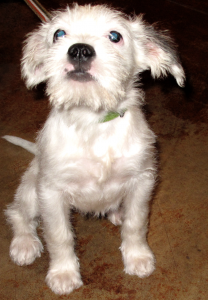 suddenly are allowed to go back to work? Adult dogs that are rescued are often prone to some degree of separation anxiety. If you think about it, it’s not an unfounded fear – they probably had another owner, and for whatever reason, lost that owner. They must worry constantly in the early days after being adopted that it could happen again. They’ll often hyper-bond to their new owner after the loss of the old one, sticking like glue to them in the house. When that new owner suddenly goes to the grocery store, the dog left behind might feel a great deal of stress.
suddenly are allowed to go back to work? Adult dogs that are rescued are often prone to some degree of separation anxiety. If you think about it, it’s not an unfounded fear – they probably had another owner, and for whatever reason, lost that owner. They must worry constantly in the early days after being adopted that it could happen again. They’ll often hyper-bond to their new owner after the loss of the old one, sticking like glue to them in the house. When that new owner suddenly goes to the grocery store, the dog left behind might feel a great deal of stress.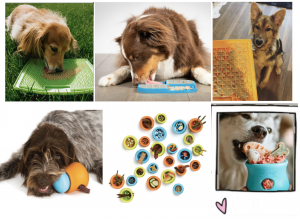 an Ex-pen can be helpful. Link the confinement to a pleasurable activity like working on a treat-stuffed puzzle/slow feeder toy (
an Ex-pen can be helpful. Link the confinement to a pleasurable activity like working on a treat-stuffed puzzle/slow feeder toy (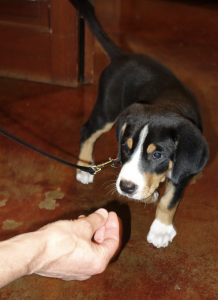 Bring treats with you on your walks. If the dog is startled by any weird sights or sounds, be upbeat, offer treats, and jolly them out of that bad feeling. “Wooo! That was a big funny dump truck wasn’t it!” is better than consoling them in a way that makes them think you also find that dump truck big and scary. Use your happy voice and manage their space if your dog is very nervous. Bring a treat pouch with you on your walks. Pairing yummy treats with the presence of something/someone that makes them uncomfortable is called Classical Conditioning, and it works! Please see
Bring treats with you on your walks. If the dog is startled by any weird sights or sounds, be upbeat, offer treats, and jolly them out of that bad feeling. “Wooo! That was a big funny dump truck wasn’t it!” is better than consoling them in a way that makes them think you also find that dump truck big and scary. Use your happy voice and manage their space if your dog is very nervous. Bring a treat pouch with you on your walks. Pairing yummy treats with the presence of something/someone that makes them uncomfortable is called Classical Conditioning, and it works! Please see 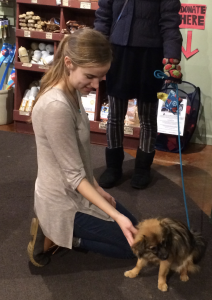
 If your puppy has had its second round of vaccines (or is meeting a dog you know is healthy and well vaccinated) you could also allow your dog to meet other dogs in this way. If both dogs are on a 6 foot leash, the humans will be at least 10 or 12 feet apart. Always ask if their dog really likes puppies (not all dogs are keen on them) and with your adult dogs, ask how they do when greeting other dogs on leash (some are great off leash but not on). It’s better they have an uneventful sighting of another dog nearby than a yucky interaction. For puppies, perhaps ask the other owner (especially if their dog seems boisterous) to keep their dog close to them, and allow your puppy to go
If your puppy has had its second round of vaccines (or is meeting a dog you know is healthy and well vaccinated) you could also allow your dog to meet other dogs in this way. If both dogs are on a 6 foot leash, the humans will be at least 10 or 12 feet apart. Always ask if their dog really likes puppies (not all dogs are keen on them) and with your adult dogs, ask how they do when greeting other dogs on leash (some are great off leash but not on). It’s better they have an uneventful sighting of another dog nearby than a yucky interaction. For puppies, perhaps ask the other owner (especially if their dog seems boisterous) to keep their dog close to them, and allow your puppy to go 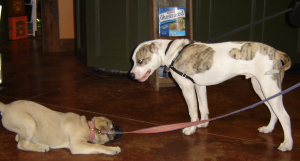 in and out as you cheer-lead her for any little progress forward. This way there’s less of a chance of your puppy becoming overwhelmed and frightened by a bigger dog enthusiastically running up and over her, which could be scary. Your aim is always to have one of two things happen: an event that is positive for them, or one where nothing exciting happens. Some dogs don’t care at all about other dogs, and will ignore the puppy that sniffs at them. Awesome! They interacted with a dog and nothing bad happened! It’s a win. Then they might meet another dog and though the puppy didn’t feel brave enough to approach entirely, nothing bad happened and you praised and were a cheerleader to your puppy and he got a little closer and was rewarded for it by you. Maybe the next dog is pretty awesome and your puppy is interested, yo-yos in and out getting closer each time while you cheered them on. They met and it was pretty fun! Now you’re getting somewhere! If a dog ever is a little scary towards the puppy, use your happy encouraging silly voice and say OK let’s go! Try and jolly the puppy back up again and create some fun on that walk to help them shake it off. Reward the sight of any dog approaching and passing by with a treat or two, to create positive feelings about dogs approaching.
in and out as you cheer-lead her for any little progress forward. This way there’s less of a chance of your puppy becoming overwhelmed and frightened by a bigger dog enthusiastically running up and over her, which could be scary. Your aim is always to have one of two things happen: an event that is positive for them, or one where nothing exciting happens. Some dogs don’t care at all about other dogs, and will ignore the puppy that sniffs at them. Awesome! They interacted with a dog and nothing bad happened! It’s a win. Then they might meet another dog and though the puppy didn’t feel brave enough to approach entirely, nothing bad happened and you praised and were a cheerleader to your puppy and he got a little closer and was rewarded for it by you. Maybe the next dog is pretty awesome and your puppy is interested, yo-yos in and out getting closer each time while you cheered them on. They met and it was pretty fun! Now you’re getting somewhere! If a dog ever is a little scary towards the puppy, use your happy encouraging silly voice and say OK let’s go! Try and jolly the puppy back up again and create some fun on that walk to help them shake it off. Reward the sight of any dog approaching and passing by with a treat or two, to create positive feelings about dogs approaching.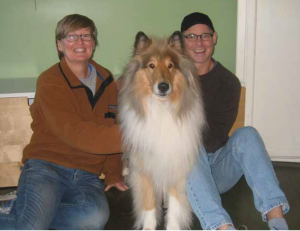 kindergarten!! These classes are currently held without owners present. They’re taught by the owners of Doggy Business, Doug and Meredith. If there’s anyone I would gladly hand over any puppy of mine to, it would be these two people. They’re also doing some virtual training classes online, and can even do one-on-one virtual sessions. These are all really amazing options and I strongly encourage you to take advantage of them. Their puppy socialization classes are amazing and include exposure to things like skateboards and vacuum cleaners, etc.
kindergarten!! These classes are currently held without owners present. They’re taught by the owners of Doggy Business, Doug and Meredith. If there’s anyone I would gladly hand over any puppy of mine to, it would be these two people. They’re also doing some virtual training classes online, and can even do one-on-one virtual sessions. These are all really amazing options and I strongly encourage you to take advantage of them. Their puppy socialization classes are amazing and include exposure to things like skateboards and vacuum cleaners, etc.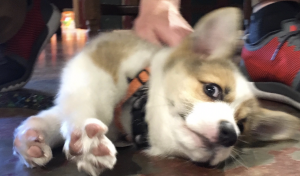 for a lifetime of care. Get your puppy used to you handling her feet (a good time is when she’s drowsy) Touch her toenails, spread her toes and look between them, and do a little massage. When this becomes normal and pleasurable to her, start holding a toe and touching something random to it, like a pencil eraser or a spoon or a bully stick (later this will be nail clippers). Reward this well with a treat or two sometimes (and give her that bully stick). Sometimes bring clippers to the couch and just have them lying around, and when you’ve had good success with other objects, touch them briefly to her toenail and reward it. When you do finally nip the tippy-tip off of one toenail, reward that really well with something amazing! (cheese? A piece of chicken?) and don’t clip any more that day. You never have to cut all nails in one sitting – it’s better to leave on a high note. It’s also best to just take the tips, even if the nails are long. Better to have a positive experience than an accidental bleeding quick. If their nails are long, the quick might be closer to the end than you think. Take the tips regularly with a little time in between to let the quick recede before you take more, and try to take the tips more often in the future to keep them at a good length.
for a lifetime of care. Get your puppy used to you handling her feet (a good time is when she’s drowsy) Touch her toenails, spread her toes and look between them, and do a little massage. When this becomes normal and pleasurable to her, start holding a toe and touching something random to it, like a pencil eraser or a spoon or a bully stick (later this will be nail clippers). Reward this well with a treat or two sometimes (and give her that bully stick). Sometimes bring clippers to the couch and just have them lying around, and when you’ve had good success with other objects, touch them briefly to her toenail and reward it. When you do finally nip the tippy-tip off of one toenail, reward that really well with something amazing! (cheese? A piece of chicken?) and don’t clip any more that day. You never have to cut all nails in one sitting – it’s better to leave on a high note. It’s also best to just take the tips, even if the nails are long. Better to have a positive experience than an accidental bleeding quick. If their nails are long, the quick might be closer to the end than you think. Take the tips regularly with a little time in between to let the quick recede before you take more, and try to take the tips more often in the future to keep them at a good length.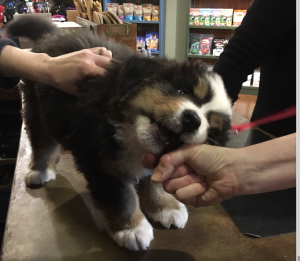 significantly painful, so it’s no surprise that people would start a “no biting” policy from the beginning. However, we feel there are important reasons not to say no mouth at all. Why? Because the early days are the only days that you can help a puppy begin to understand the difference between a gentle mouth and a hard mouth, and the only time that you can create a dog who automatically inhibits the force of his bite later in life. Developing “bite inhibition” means that if he does happen to bite, he is less likely to inflict as much damage as a dog without any automatic bite inhibition. It is critical to keeping people and other dogs safe if he were to ever bite someone. The truth is, any dog, no matter how sweet and trustworthy and gentle, might find themselves in an extraordinary situation. If he were in a dog fight, he might defend himself. Or if he were in a car accident and a stranger reaches into the car to get him out, he may be so stressed that he bites. If he is an old dog and in some sort of very bad pain you are unaware of like undiagnosed bone cancer and a child trips and falls on the dog, the startled dog feeling pain might bite. When a dog grows up with no bite inhibition, these bites could be much more injurious.
significantly painful, so it’s no surprise that people would start a “no biting” policy from the beginning. However, we feel there are important reasons not to say no mouth at all. Why? Because the early days are the only days that you can help a puppy begin to understand the difference between a gentle mouth and a hard mouth, and the only time that you can create a dog who automatically inhibits the force of his bite later in life. Developing “bite inhibition” means that if he does happen to bite, he is less likely to inflict as much damage as a dog without any automatic bite inhibition. It is critical to keeping people and other dogs safe if he were to ever bite someone. The truth is, any dog, no matter how sweet and trustworthy and gentle, might find themselves in an extraordinary situation. If he were in a dog fight, he might defend himself. Or if he were in a car accident and a stranger reaches into the car to get him out, he may be so stressed that he bites. If he is an old dog and in some sort of very bad pain you are unaware of like undiagnosed bone cancer and a child trips and falls on the dog, the startled dog feeling pain might bite. When a dog grows up with no bite inhibition, these bites could be much more injurious. 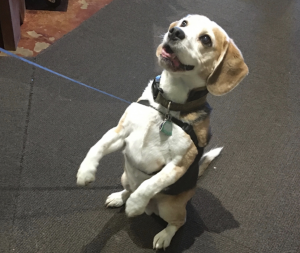 ou really can get a lot of training work done with any dog in your household with this time on your hands.
Teaching new tricks and skills is fun and mentally challenging for both the people and the dogs.
ou really can get a lot of training work done with any dog in your household with this time on your hands.
Teaching new tricks and skills is fun and mentally challenging for both the people and the dogs.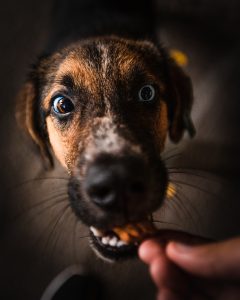

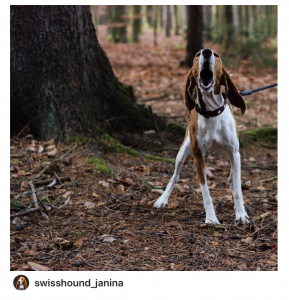 he met another dog with poor social skills, had a very scary scuffle and came out with some small wounds. He starts to bark at other dogs on walks, trying to keep dogs out of his space. It seems to work as the owner gets him out of the situation, but the owner is starting to feel very self conscious about her dog’s behavior. When she sees another dog coming, she says “Uh Oh” and her worry and agitation that it’s about to happen again is conveyed to her dog. She transmits all sorts of warning signals to her dog, gathering his leash tighter, feeling worried, inadvertently signaling to him that other dogs are indeed very bad. The dog starts to sound the alarm, the owner yanks him away and scolds him for his outburst, feeling embarrassed in front of the other owner.
he met another dog with poor social skills, had a very scary scuffle and came out with some small wounds. He starts to bark at other dogs on walks, trying to keep dogs out of his space. It seems to work as the owner gets him out of the situation, but the owner is starting to feel very self conscious about her dog’s behavior. When she sees another dog coming, she says “Uh Oh” and her worry and agitation that it’s about to happen again is conveyed to her dog. She transmits all sorts of warning signals to her dog, gathering his leash tighter, feeling worried, inadvertently signaling to him that other dogs are indeed very bad. The dog starts to sound the alarm, the owner yanks him away and scolds him for his outburst, feeling embarrassed in front of the other owner.  good choice making it likely I’ll try to make that choice again and again) and reward that quiet dog when he could have barked and didn’t. She might also start to ask for behaviors that help him deal with the situation like “Watch Me” and reward those behaviors frequently. So, creating the simple association between “dog in view” and “cheese” can have powerful effects, and eventually that dog can be asked to be closer to other dogs and still be able to hold it together, gaining confidence around other dogs, becoming more relaxed in their relative presence, and also gaining confidence in his owner to manage his space. It works.
good choice making it likely I’ll try to make that choice again and again) and reward that quiet dog when he could have barked and didn’t. She might also start to ask for behaviors that help him deal with the situation like “Watch Me” and reward those behaviors frequently. So, creating the simple association between “dog in view” and “cheese” can have powerful effects, and eventually that dog can be asked to be closer to other dogs and still be able to hold it together, gaining confidence around other dogs, becoming more relaxed in their relative presence, and also gaining confidence in his owner to manage his space. It works. face, or slapping them when they see a spider will help at all to make that fear of spiders go away, even if they can learn to suppress their screams to avoid a slap. It will only work to deepen their agitation about a spider’s presence. (And there will always be a distinct possibility that the sudden sight of a spider will make them scream anyway if they’re unprepared).
face, or slapping them when they see a spider will help at all to make that fear of spiders go away, even if they can learn to suppress their screams to avoid a slap. It will only work to deepen their agitation about a spider’s presence. (And there will always be a distinct possibility that the sudden sight of a spider will make them scream anyway if they’re unprepared).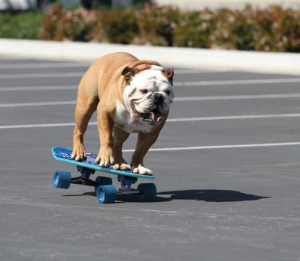
 Trainers that use punishment often insist that just about every undesirable dog behavior can be attributed to their yearning for status, and that dominance is the underlying motivator for their actions. They have been led to believe that because they descended from wolves, that they must be in constant competition with members of their pack. The big trouble with this is that wild wolves don’t behave this way. There was a study in the 1930s that was reproduced a number of times by others that put unrelated adult wolves together in an artificial captive situation and discovered that they did indeed fight violently. Wild wolves are found in smaller family groups consisting of mated pairs and their offspring who stay in the group for several years. Sometimes families that know each other will come together for a time when resources are plentiful, and perhaps split up again when prey is scarce. When adolescents mature, they’ll leave the family to make their own. The only constant members of the group are the mated pair. It’s very unnatural to confine adult, unrelated strangers in a small captive setting, and this is a recipe for constant fighting and competition for resources.
Trainers that use punishment often insist that just about every undesirable dog behavior can be attributed to their yearning for status, and that dominance is the underlying motivator for their actions. They have been led to believe that because they descended from wolves, that they must be in constant competition with members of their pack. The big trouble with this is that wild wolves don’t behave this way. There was a study in the 1930s that was reproduced a number of times by others that put unrelated adult wolves together in an artificial captive situation and discovered that they did indeed fight violently. Wild wolves are found in smaller family groups consisting of mated pairs and their offspring who stay in the group for several years. Sometimes families that know each other will come together for a time when resources are plentiful, and perhaps split up again when prey is scarce. When adolescents mature, they’ll leave the family to make their own. The only constant members of the group are the mated pair. It’s very unnatural to confine adult, unrelated strangers in a small captive setting, and this is a recipe for constant fighting and competition for resources.  through doorways first. What silly person came up with the notion that a dog would understand, let alone exert dominance, by preceding his owner out the front door? When dogs are rushing through doors, mustn’t we first rule out that they are trying to close distance between themselves and whatever is out there, as quickly as possible, because they are excited, because they are dogs, and because they have never been presented with a reason not to?”
through doorways first. What silly person came up with the notion that a dog would understand, let alone exert dominance, by preceding his owner out the front door? When dogs are rushing through doors, mustn’t we first rule out that they are trying to close distance between themselves and whatever is out there, as quickly as possible, because they are excited, because they are dogs, and because they have never been presented with a reason not to?”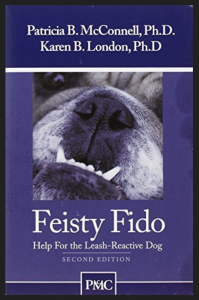
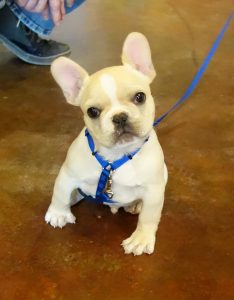 Often we hapless humans try our best to tell our puppies (and kittens) what we want them to do or especially not do, yet the bad behaviors increase and we struggle to get them to be what we wish they would be, especially when it comes to attention-getting behaviors. I’m here to offer a few rules of thumb for most any behavior you don’t like. First, I’ll say that punishment doesn’t need to be part of the picture. Punishing him for wanting your attention can erode your relationship. It’s sweet that he wants your attention, but he’s asking for it in the wrong way.
Often we hapless humans try our best to tell our puppies (and kittens) what we want them to do or especially not do, yet the bad behaviors increase and we struggle to get them to be what we wish they would be, especially when it comes to attention-getting behaviors. I’m here to offer a few rules of thumb for most any behavior you don’t like. First, I’ll say that punishment doesn’t need to be part of the picture. Punishing him for wanting your attention can erode your relationship. It’s sweet that he wants your attention, but he’s asking for it in the wrong way.